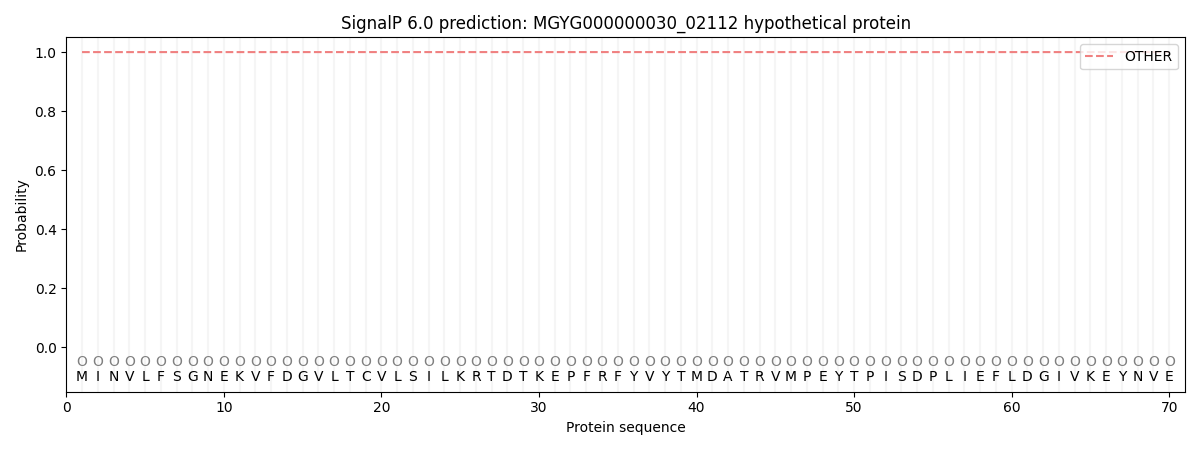You are browsing environment: HUMAN GUT
CAZyme Information: MGYG000000030_02112
You are here: Home > Sequence: MGYG000000030_02112
Basic Information |
Genomic context |
Full Sequence |
Enzyme annotations |
CAZy signature domains |
CDD domains |
CAZyme hits |
PDB hits |
Swiss-Prot hits |
SignalP and Lipop annotations |
TMHMM annotations
Basic Information help
| Species | CAG-603 sp900066105 | |||||||||||
|---|---|---|---|---|---|---|---|---|---|---|---|---|
| Lineage | Bacteria; Firmicutes_A; Clostridia; Lachnospirales; Lachnospiraceae; CAG-603; CAG-603 sp900066105 | |||||||||||
| CAZyme ID | MGYG000000030_02112 | |||||||||||
| CAZy Family | GT8 | |||||||||||
| CAZyme Description | hypothetical protein | |||||||||||
| CAZyme Property |
|
|||||||||||
| Genome Property |
|
|||||||||||
| Gene Location | Start: 170883; End: 171722 Strand: + | |||||||||||
CAZyme Signature Domains help
| Family | Start | End | Evalue | family coverage |
|---|---|---|---|---|
| GT8 | 3 | 227 | 1.7e-31 | 0.8404669260700389 |
CDD Domains download full data without filtering help
| Cdd ID | Domain | E-Value | qStart | qEnd | sStart | sEnd | Domain Description |
|---|---|---|---|---|---|---|---|
| cd04194 | GT8_A4GalT_like | 3.53e-35 | 2 | 212 | 1 | 208 | A4GalT_like proteins catalyze the addition of galactose or glucose residues to the lipooligosaccharide (LOS) or lipopolysaccharide (LPS) of the bacterial cell surface. The members of this family of glycosyltransferases catalyze the addition of galactose or glucose residues to the lipooligosaccharide (LOS) or lipopolysaccharide (LPS) of the bacterial cell surface. The enzymes exhibit broad substrate specificities. The known functions found in this family include: Alpha-1,4-galactosyltransferase, LOS-alpha-1,3-D-galactosyltransferase, UDP-glucose:(galactosyl) LPS alpha1,2-glucosyltransferase, UDP-galactose: (glucosyl) LPS alpha1,2-galactosyltransferase, and UDP-glucose:(glucosyl) LPS alpha1,2-glucosyltransferase. Alpha-1,4-galactosyltransferase from N. meningitidis adds an alpha-galactose from UDP-Gal (the donor) to a terminal lactose (the acceptor) of the LOS structure of outer membrane. LOSs are virulence factors that enable the organism to evade the immune system of host cells. In E. coli, the three alpha-1,2-glycosyltransferases, that are involved in the synthesis of the outer core region of the LPS, are all members of this family. The three enzymes share 40 % of sequence identity, but have different sugar donor or acceptor specificities, representing the structural diversity of LPS. |
| pfam01501 | Glyco_transf_8 | 4.45e-17 | 3 | 194 | 1 | 197 | Glycosyl transferase family 8. This family includes enzymes that transfer sugar residues to donor molecules. Members of this family are involved in lipopolysaccharide biosynthesis and glycogen synthesis. This family includes Lipopolysaccharide galactosyltransferase, lipopolysaccharide glucosyltransferase 1, and glycogenin glucosyltransferase. |
| COG1442 | RfaJ | 8.05e-15 | 2 | 212 | 3 | 211 | Lipopolysaccharide biosynthesis protein, LPS:glycosyltransferase [Cell wall/membrane/envelope biogenesis]. |
| cd00505 | Glyco_transf_8 | 2.77e-12 | 15 | 212 | 15 | 212 | Members of glycosyltransferase family 8 (GT-8) are involved in lipopolysaccharide biosynthesis and glycogen synthesis. Members of this family are involved in lipopolysaccharide biosynthesis and glycogen synthesis. GT-8 comprises enzymes with a number of known activities: lipopolysaccharide galactosyltransferase, lipopolysaccharide glucosyltransferase 1, glycogenin glucosyltransferase, and N-acetylglucosaminyltransferase. GT-8 enzymes contains a conserved DXD motif which is essential in the coordination of a catalytic divalent cation, most commonly Mn2+. |
| cd06431 | GT8_LARGE_C | 8.91e-05 | 16 | 194 | 16 | 198 | LARGE catalytic domain has closest homology to GT8 glycosyltransferase involved in lipooligosaccharide synthesis. The catalytic domain of LARGE is a putative glycosyltransferase. Mutations of LARGE in mouse and human cause dystroglycanopathies, a disease associated with hypoglycosylation of the membrane protein alpha-dystroglycan (alpha-DG) and consequent loss of extracellular ligand binding. LARGE needs to both physically interact with alpha-dystroglycan and function as a glycosyltransferase in order to stimulate alpha-dystroglycan hyperglycosylation. LARGE localizes to the Golgi apparatus and contains three conserved DxD motifs. While two of the motifs are indispensible for glycosylation function, one is important for localization of th eenzyme. LARGE was originally named because it covers approximately large trunck of genomic DNA, more than 600bp long. The predicted protein structure contains an N-terminal cytoplasmic domain, a transmembrane region, a coiled-coil motif, and two putative catalytic domains. This catalytic domain has closest homology to GT8 glycosyltransferase involved in lipooligosaccharide synthesis. |
CAZyme Hits help
| Hit ID | E-Value | Query Start | Query End | Hit Start | Hit End |
|---|---|---|---|---|---|
| QQA01162.1 | 6.14e-139 | 1 | 277 | 1 | 277 |
| QNL97925.1 | 3.11e-133 | 1 | 277 | 1 | 277 |
| AEE15925.1 | 2.45e-72 | 1 | 278 | 1 | 276 |
| QAT42778.1 | 3.50e-66 | 3 | 274 | 2 | 275 |
| ANK66321.1 | 2.49e-65 | 3 | 271 | 2 | 272 |
Swiss-Prot Hits download full data without filtering help
| Hit ID | E-Value | Query Start | Query End | Hit Start | Hit End | Description |
|---|---|---|---|---|---|---|
| P43974 | 1.65e-08 | 3 | 180 | 40 | 210 | Putative glycosyltransferase HI_0258 OS=Haemophilus influenzae (strain ATCC 51907 / DSM 11121 / KW20 / Rd) OX=71421 GN=HI_0258 PE=3 SV=2 |
SignalP and Lipop Annotations help
This protein is predicted as OTHER

| Other | SP_Sec_SPI | LIPO_Sec_SPII | TAT_Tat_SPI | TATLIP_Sec_SPII | PILIN_Sec_SPIII |
|---|---|---|---|---|---|
| 1.000044 | 0.000000 | 0.000000 | 0.000000 | 0.000000 | 0.000000 |
